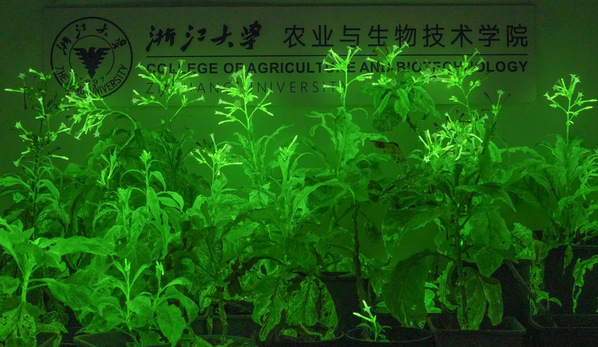Zhejiang University: Plant luminescence aids low-carbon lifestyle
It is a revolutionary practice to promote eco-friendly production modes and low-carbon lifestyles. Lighting accounts for approximately 20% of global energy consumption and plays a paramount role in researching into the sustainable use of energy for mankind. As biotechnology is burgeoning today, the luminous “fantasy forest” no longer exists in the realm of science fiction, and plant luminescence, as an ideal way of sustainable resource utilization, has inched towards the reality, opening the door for a green and low-carbon lifestyle in the future.
Recently, the research team led by DU Hao from the Zhejiang University College of Agriculture and Biotechnology developed a type of plants with an enhanced fungal bioluminescence pathway (FBP) which could illuminate their surroundings and display words clearly in the dark. This latest research result was published in Plant Biotechnology Journal.
In the work, the researchers integrated a particular gene (C3’H1) from Brassica napus and a specific gene (NPGA) a null-pigment mutant in A. nidulans) into the original FPB module. They transferred them into plants using a multi-gene assembly method and achieved continuous, stable and low-intensity illumination. “The plants we obtained could not only improve their luminescence by five times compared with the original luminescent plants but also emit light visible to naked human eyes in a sustained and steady manner. The leaves treated in vitro could also continuously emit light for as long as three days,” said ZHENG Peng, a postdoctoral fellow at the College of Agriculture and Biotechnology and first author of the study.
This luminescence system can be developed into a potential tool for the detection of basic biomolecules in plants and animals in the future. In this way, the researchers won’t have to rely on expensive and large detection instruments. Instead, they can simply observe biomolecules with naked eyes or use ordinary cameras. Moreover, no exogeneous substrate needs to be added during the luminescence process. The system can be used for high-throughput in vivo detection in a cost-effective and convenient way. Besides, it can be used as a crop detection sensor, thereby showing enormous promise in healthy and smart agriculture.
“We will continue to create new luminescent plant species with an enhanced FPB. This has been achieved in ornamental plants such as poplars, iris and chrysanthemum. Our luminescence system has universal value in herbaceous plants and perennial woody plants. Meanwhile, we have created luminescent poplars with stable genetic configurations, and we hope to develop applications in more plants in the future,” said GE Jieyu, a graduate student at the College of Agriculture and Biotechnology and one of the authors in this work.
Bioluminescent plants open up a new avenue to bioenergy conversion and utilization, as they can use photosynthesis to convert solar energy into organic matter and fix CO2 in the air during the daytime and release light energy and apply low-brightness lighting at night. These bioluminescent plants are conducive to saving electricity and reducing carbon emissions, and they will therefore act as a propeller in attaining the goal of the “double carbon” strategy and creating a realistic world as in “Avatar”, a science-fiction film.

